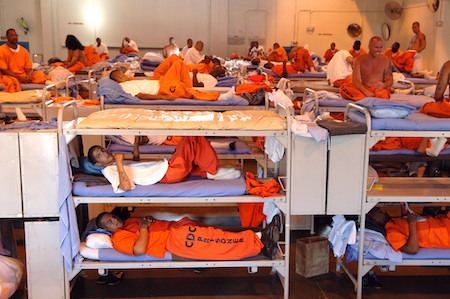For decades, the federal government used its grant-making power to spur states to incarcerate more people and to impose longer sentences. It should now use that power to reverse course.
From The Brennan Center for Justice:
Few issues have received more sustained attention from U.S. policymakers over the last decade than the country’s unique overuse of incarceration. After decades of growth in imprisonment rates, states have attempted to reduce the number of people behind bars. Their reforms have been driven by a recognition that incarceration is expensive and often counterproductive and by research demonstrating that many people can be safely supervised in the community. Much incarceration is also unnecessary. According to a 2016 Brennan Center for Justice report, nearly 40 percent of the U.S. prison population is incarcerated without any compelling public safety justification. Incarceration degrades people’s humanity, disrupts their social networks, and causes lifelong social and financial disadvantage through restricted access to education, jobs, and housing. It also devastates families and communities, disproportionately affecting society’s most marginalized segments.
Reforms have reduced the population behind bars from its 2009 peak, yet an astonishing level of incarceration persists: today over 1.2 million people are confined to federal and state prisons, and just over 636,000 more are locked up in local jails. Few states have achieved significant reductions in their prison populations, and in some places these populations have begun to grow again.
For a half century, the federal government has harnessed its grant-making power to spur states to incarcerate more people and to impose longer sentences, making the United States the most punitive country in the world. It can now use that same funding power to reverse course.
The idea of using federal funding to reduce incarceration is not new, but recent programs have had mixed results. For example, between 2010 and 2017, the U.S. Department of Justice’s Justice Reinvestment Initiative (JRI) provided state and local governments with technical assistance and direct funding to reduce their prison populations. But this funding did not always produce the intended outcome. Some states, such as Kentucky, actually saw their prison populations grow after implementing reforms with JRI funding and assistance. Compounding matters, between 2018 and 2021, under President Trump, JRI pivoted away from prison population reduction as a primary objective, refocusing it on crime and recidivism reduction, particularly as it relates to violent crime.
Yet since assuming office in 2021, the Biden administration, while retaining JRI’s focus on recidivism reduction, now specifically allows grant money to support efforts to reduce incarceration for new crimes or technical violations of community supervision. And more recently, in August 2022, as part of his 2023 budget proposal to Congress, President Biden unveiled a grant program called Accelerating Justice System Reform, which would dedicate $15 billion over 10 years for jurisdictions to implement crime prevention and public health approaches to public safety.
Building on this momentum, the Brennan Center for Justice calls on Congress to enact a new, $1 billion federal funding program, called the Public Safety and Prison Reduction Act, to channel money to states with the goal of reducing unnecessary incarceration while promoting humane and fair criminal-justice policies that preserve public safety. The proposal, based on a previous Brennan Center policy solution — the Reverse Mass Incarceration Act — was crafted in consultation with a variety of stakeholders, including formerly incarcerated individuals.
The grant program would be structured to do the following:
- offer states federal dollars to study the drivers of unnecessary incarceration and additional money to reduce prison populations;
- reward states that shrink their prison populations by 20 percent over three years with an extra three years of funding;
- afford states freedom to implement federal funding on the basis of local considerations by providing them a slate of 21 policy options from which to choose;
- track and measure success of grantees’ policy changes by mandating that states, in partnership with researchers or an academic institution, submit annual progress reports to the federal government describing and evaluating expenditures;
- require states to convene an advisory board composed of a diverse array of local stakeholders, including formerly incarcerated people;
- prohibit states from enacting punitive sentencing laws such as mandatory-minimum rules or truth-in-sentencing statutes during the lifetime of the funding; and
- establish subgrants for organizations that are led by formerly incarcerated individuals or that serve high numbers of people who have been arrested or convicted.
The impact of this policy would be historic. If the 25 states with the largest prison populations used these funds to reduce imprisonment by 20 percent, 178,000 fewer people would be confined (see figure 1). That would slash state prison populations by more people than are currently incarcerated in the entire federal prison system. The United States’ incarcerated population would decrease to numbers last seen before 1993, the year before the Violent Crime Control and Law Enforcement Act of 1994 — often called the 1994 crime bill — was signed into law by President Bill Clinton.
This prison population reduction estimate is a conservative one. States that reduced their prison populations by 20 percent in the first three years of the grant period would be eligible for additional funds under the program, providing them with resources to make even greater reductions.
Although criminal justice administration is a core function of state and local governments, the federal government nonetheless has a vital role to play in both messaging the need to dismantle mass incarceration and incentivizing states to pursue systemic reforms toward that end. This report first delves into the history of the federal government’s role in encouraging overly punitive responses to crime and social disorder. It then outlines the new policy proposal, for which model statutory language is provided in the appendix. Given the fiscal costs and social harms of mass incarceration, the federal government must reorient its grant spending to press states to end punitive policies that fail to deliver public safety.
